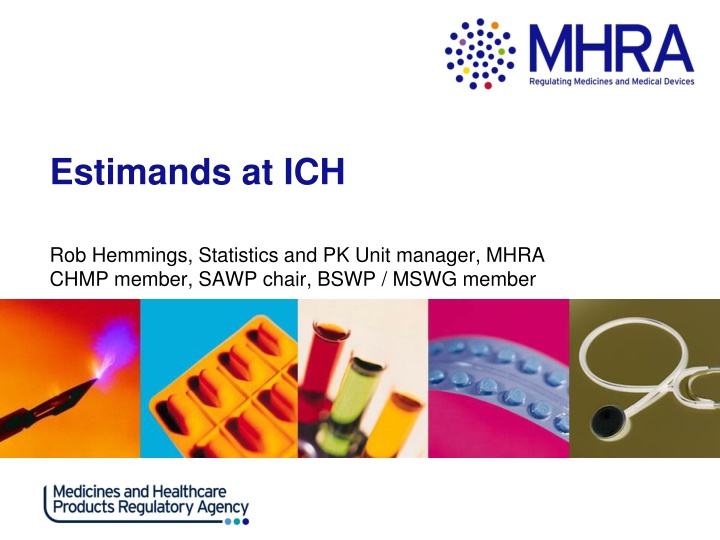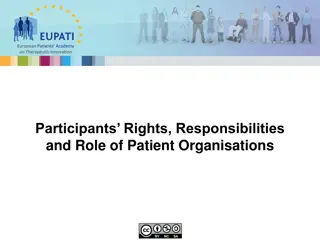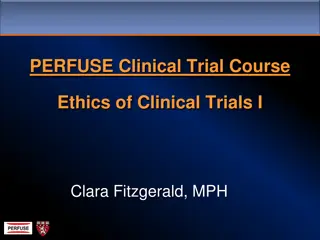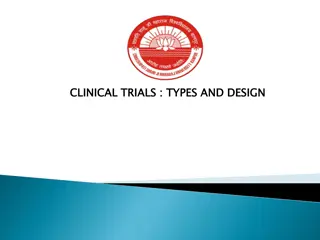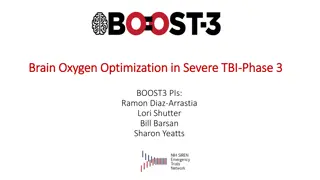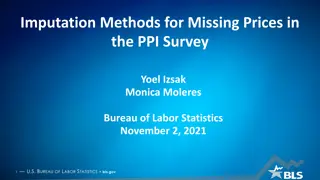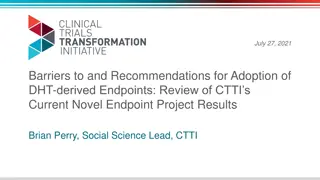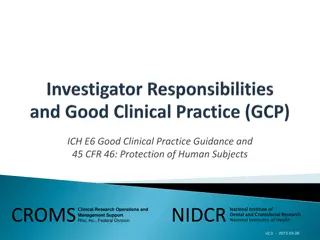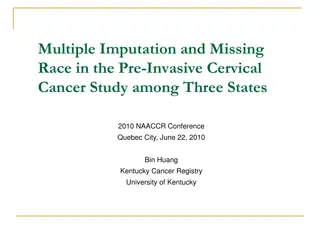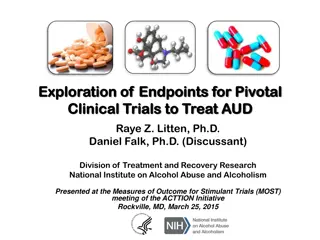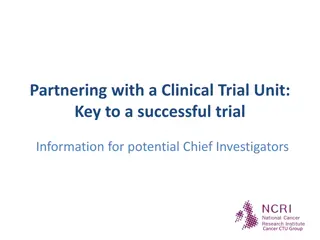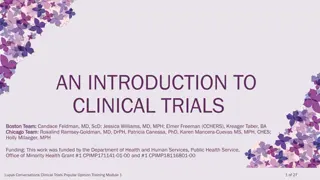Challenges in Missing Data Handling in Clinical Trials
Long-standing approaches for handling missing data in clinical trials are being questioned, leading to discussions on the appropriateness and implications of methods like MMRM. Regulators emphasize the importance of selecting methods based on the trial's context rather than the method's properties. Key principles such as the Intention-To-Treat principle play a significant role in evaluating treatment effects in clinical trials.
Download Presentation

Please find below an Image/Link to download the presentation.
The content on the website is provided AS IS for your information and personal use only. It may not be sold, licensed, or shared on other websites without obtaining consent from the author.If you encounter any issues during the download, it is possible that the publisher has removed the file from their server.
You are allowed to download the files provided on this website for personal or commercial use, subject to the condition that they are used lawfully. All files are the property of their respective owners.
The content on the website is provided AS IS for your information and personal use only. It may not be sold, licensed, or shared on other websites without obtaining consent from the author.
E N D
Presentation Transcript
Estimands at ICH . Rob Hemmings, Statistics and PK Unit manager, MHRA CHMP member, SAWP chair, BSWP / MSWG member
Contents Need for a new framework Why ICH? How? Who? When? What? What next? Example to support discussion 2
Disclaimer Obligatory disclaimer: The views expressed in this presentation are my own and do not necessarily reflect those of MHRA or EMA. Acknowledgements: In fact the views are, at least in part, from the (excellent) E9(R1) Expert Working Group. 3
Need for a new framework Long-standing approaches for the handling of missing data were (appropriately) challenged and a long conversation ensued.... perhaps the wrong conversation. We started to talk about methods LOCF vs MMRM, then MMRM vs others. 4
Need for a new framework MMRM in majority of industry-sponsored trials. because it is most appropriate, or because it is easy? Regulators not yet sold MMRM appears to answer the question of what would have happened if patients had stayed on randomised treatment. They didn t, and some won t. 5
Need for a new framework So what do we want to know? EMA guideline on missing data states: The justification for selecting a particular method should not be based primarily on the properties of the method under particular assumptions but on whether it is likely that it will provide an appropriate estimate for the comparison of primary regulatory interest in the circumstances of the trial under consideration 6
Need for a new framework So what do we want to know? E9: Intention-To-Treat Principle: The principle that asserts that the effect of a treatment policy can be best assessed by evaluating on the basis of the intention to treat a subject (i.e. the planned treatment regimen) rather than the actual treatment given. It has the consequence that subjects allocated to a treatment group should be followed up, assessed and analysed as members of that group irrespective of their compliance to the planned course of treatment. 7
Need for a new framework Preservation of the initial randomisation in analysis is important in preventing bias and in providing a secure foundation for statistical tests. Not only analyse as randomise anything else will be harder When the full analysis set of subjects is used, violations of the protocol that occur after randomisation may have an impact on the data and conclusions, particularly if their occurrence is related to treatment assignment. In most respects it is appropriate to include the data from such subjects in the analysis, consistent with the intention-to-treat principle. 8
Need for a new framework From E9R(1) Concept Paper: Remarkably, despite many years of clinical trials being the primary support for regulatory decision making, no definitive guidance is available on what constitutes an appropriate primary estimand for a confirmatory clinical trial. The absence of regulatory guidance leads to uncertainties and inconsistencies in methodological approach across trial designs supporting regulatory decisions. 9
Need for a new framework From E9R(1) Concept Paper: Furthermore, similar submissions may lead to different inferences being drawn by different regulatory authorities for reasons that appear to have nothing to do either with actual regional differences or even with clear differences of opinion in benefit-risk appraisal, but rather with a lack of what could be a common understanding of trial objectives and of what constitutes an appropriate quantification of the effects of an experimental treatment. 10
Need for a new framework So what do we want to know? Depends on context? What is done at present? Not really specified ( ITT is said, but its not) Statistical section determines the precise trial objective How should we handle missing data? became What question are we really interested to answer? If we re going to try to sort this out, let s do it globally = ICH 11
Why ICH? Unique harmonisation project involving the Regulators and research-based Industries of US, EU and Japan started in 1990 WHO, Canada, and EFTA are observers Well-defined objectives: To improve efficiency of new drug development and registration process To promote public health, prevent duplication of clinical trials in humans and minimise the use of animal testing without compromising safety and effectiveness Accomplished through the development and implementation of harmonised Guidelines and standards 12
How? Technical Working Groups Structure DRAs/DoH DRA of Australia DRA of Brazil DRA of China DoH of Chinese Taipei DRA of India DRA of Korea DRA of Russia DRA of Singapore Interested Parties IGPA WSMI Biotechnology Industry IPEC API Industry PIC/s Pharmacopoeias Europe Japan United States RHIs APEC ASEAN EAC GCC PANDRH SADC *Experts are nominated by their regional Coordinators 13
Overview of ICH Steps in the ICH Process 14
Overview of ICH Steps in the ICH Process A formal sign-off can be achieved only when consensus is reached within the 6 ICH Parties. (*** exceptionally regulators only) The Secretariat should be contacted to initiate the sign-off process. When consensus is reached among all six-party expert on the technical Document, the Topic Leaders in the EWG will sign the Step 1 Experts Sign-off sheet. The Step 1 Experts Document with EWG signatures is submitted to the Steering Committee to request adoption under Step 2a of the ICH process . At Step 2a, the six Parties are requested to sign-off the consensus technical document. At Step 2b, the consensus text approved by the three regulatory ICH Parties is signed-off by the three regulatory ICH Parties as Step 2b draft Guideline with a view to releasing it for public consultation. The technical document is made public on the ICH website alongside the draft Guideline. 15
Overview of ICH Steps in the ICH Process A formal sign-off can be achieved only when consensus is reached within the 6 ICH Parties. At Step 3, the comments received by each of the three Regulatory Parties shall be consolidated. The Step 3 experts document is signed-off by the regulatory Topic Leaders. At Step 4, the Steering Committee Regulatory Parties are signing- off the final document. Upon reaching Step 2b or Step 4, the Rapporteur shall develop a presentation to be published along the Guideline on the ICH website, as support documentation. 16
Who? EU: Rob Hemmings, Frank Petavy FDA: Tom Permutt, Estelle Russek-Cohen MHLW: (PMDA): Yuki Ando, Hirofumi Minami, Ayako Hara EFPIA: Christine Fletcher, Frank Bretz PhRMA: Devan Mehrotra, Vladamir Dragalin JPMA: Satoru Tsuchiya, Satoru Fukinbara, Hideki Suganami Health Canada, Brazil, Australia, Chinese Taipei / Taiwan 17
When? Concept Paper approved mid 2014 Expert Working Group met in Lisbon, Nov 2014 and Fukuoka, June 2015 Next meeting Jacksonville, Dec 2015 or Europe mid-2016. Step 1 ??? 18
What? Technical document Draft addendum to ICH E9 Appendix Update (additions / clarifications) to ICH E9 19
What? Motivation Framework Estimand definitions Factors influencing estimand selection? Scientific preferences and regulatory demands Impact on trial planning, documentation, conduct Also sensitivity analyses 20
What? Improved framework for clinical trial planning, conduct, analysis and interpretation. Trial Objective (Consequent) Estimand (Choice of) Analysis methodology (Consequent) Sensitivity Analyses 21
What? The key message is the importance of clearly formulating and articulating, in order, the trial objectives, estimand, informing design and analysis. 22
What? 5 constructs from NAS report for illustration: (Difference in) mean outcome improvement for all randomized participants. (Difference in) outcome improvement in those who adhere to treatment. (Difference in) outcome improvement if all participants had adhered. (Difference in) areas under the outcome curve during adherence to treatment. (Difference in) outcome improvement during adherence to treatment Mallinckrodt et al, give a further illustration: For all randomized participants at the planned endpoint of the trial attributable to the initially randomized treatment 23
What? Are reliable estimators / estimates available? Factors influencing estimand selection? therapeutic setting? most focus on chronic treatments, repeated measures. clinical use? pharmacology? intent of treatment? toxicity? availability of other treatments, possibility for rescue / monitoring? what else? 24
A word on sensitivity analyses EU proposed estimand . This was born out of the missing data discussions, but became a broader, more fundamental question. FDA proposed sensitivity analysis . This was always broader than only a missing data problem, and seeks to improve structure. The topics are related to the extent that harmonisation may improve trial planning, conduct, analysis, reporting and decision making. 25
What next? Drafting and discussion Consultations in local stakeholder groups More drafting and discussion Step 1, 2a, 2b Public consultation 26
Motivating example, Selincro The efficacy and tolerability of nalmefene in the treatment of alcohol dependence were evaluated in three randomised, double-blind, placebo-controlled phase III studies (two confirmatory 6-month efficacy studies and one 1-year safety study) Primary Objectives: The overall objective of the study was to evaluate the effect of as-needed dosing of 18.06 mg nalmefene on alcohol consumption in patients with alcohol dependence during a 24-week treatment period. 27
Motivating example, Selincro Primary endpoints: The changes from baseline to Month 6 in number of Heavy Drinking Days (HDDs) and Total alcohol consumption (TAC) were defined as the two co-primary efficacy endpoints, as follows: 1. Number of HDDs (defined as a day with alcohol consumption 60g for men and 40g for women) 2. Total alcohol consumption (TAC, defined as mean daily alcohol consumption in g/day over a month (= 28 days) Both co-primary efficacy variables concerned the treatment effect at Month 6. Efficacy analyses were conducted on all treated patients who had at least one valid post-baseline assessment. 28
Motivating example, Selincro The primary analysis pre-specified for both co- primary efficacy variables was a mixed model repeated measures (MMRM) analysis using all available data measured over each month during the treatment period using a model with baseline score as covariate, site, sex, time and treatment as fixed effects, baseline-by-time and treatment-by- time interaction and an unstructured covariance matrix. Sensitivity analyses were pre-specified including placebo mean imputation (PMI) and multiple imputation with a pattern mixture model. 29
Motivating example, Selincro Example study: 18% stopped drinking between screening and randomisation 31% of the placebo-treated patients and 53% of the nalmefene-treated patients withdrew from the study; the most frequent primary reason for withdrawal was withdrawal of consent in the placebo group and adverse events in the nalmefene group, time to withdrawal for any reason shows a pattern of earlier withdrawal in the nalmefene group than in the placebo group. 30
Which estimand? (Difference in) mean outcome improvement for all randomized participants. (Difference in) outcome improvement in those who adhere to treatment. (Difference in) outcome improvement if all participants had adhered. (Difference in) areas under the outcome curve during adherence to treatment. (Difference in) outcome improvement during adherence to treatment For all randomized participants at the planned endpoint of the trial attributable to the initially randomized treatment Other? 33
Conclusions The work seems to be important. The framework seems to have been well received. The work is continuing. Views are welcome. 34
